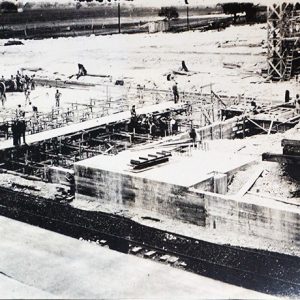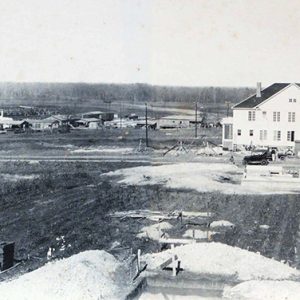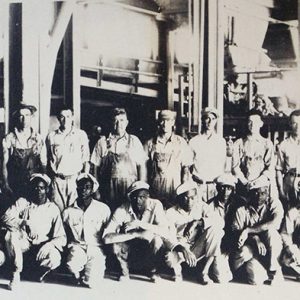calsfoundation@cals.org
Okay (Howard County)
Until the late 1980s, the town of Okay in Howard County was home to a major limestone mining operation located on a peninsula on the east side of Millwood Lake. Most of what remained of the once-thriving company town, founded in the late 1920s, had almost disappeared by the end of the twentieth century.
In 1926, Charles Boettcher, founder of Ideal Cement Company, based in Denver, Colorado, dispatched Tom Dodson and Joe Hargis from a branch plant in Oklahoma to scout out a potential Arkansas plant site after learning of the growing movement in Arkansas to improve roads and bridges. A remote site in Howard County was chosen due to its rich deposits of limestone and chalk.
A railroad spur necessary for moving in equipment was first built connecting the site to the main railroad line. Cement foundations were poured in November 1928. Almost a year later, the $1 million Arkansas Portland O. K. Cement Company was dedicated with an explosion of a 20,200-pound dynamite blast at the new quarry. On October 2, 1929, less than a month before the stock market crash, the plant began production. Roy King tied the first bag of cement to come off the production line, and, on October 2, the first 125 car loads of cement were shipped. The original capacity of the plant was approximately four million sacks a year.
While the plant was under construction, an employee village of some forty small homes was also built. Named after the company’s OK brand cement, it included everything needed by residents. Indoor water, sewer, electricity, and gas were available, with water and electricity provided free by the company. On February 11, 1930, a post office opened. The Okay Mercantile, run by Frank Norden and Jim Smith, provided shopping opportunities for the residents. On the second floor of the store was a meeting hall, and church services were held there for a time. A separate clubhouse was provided for management.
Recreational facilities were built for tennis, golf, croquet, basketball, and baseball. On May 24, 1936, a baseball diamond, home of the company team the Okay Cementers, opened. The Cementers became one of the area’s best semi-professional teams.
During plant construction, an agreement was struck with the nearby Saratoga Special District to build a school for grades 1–6 at Okay on land donated by the company. All other grades attended the Saratoga (Howard County) school. Classes were held in a bunkhouse while a school building was under construction. Cecil Shuffield served as the first principal. In 1937, a sixth- and seventh-grade building was put into use, along with a lunchroom that was said to be one of the first in the state. The Depression-era Works Progress Administration (WPA) constructed a gym in 1939. In 1963, as the company began to cut back, all students were sent to Saratoga. Author Myra Dell McLarey, best known for her novel Water from the Well, attended school at Okay.
During the Great Depression, the plant was forced to close intermittently. However, the company benefitted when Huey Long, governor of Louisiana, initiated a major bridge and road construction project. Much of the cement for these projects was produced at Okay. Though many of the plant’s male employees served in World War II, the plant operated at full capacity. One controversial issue in the 1940s concerned the company’s initial opposition to the construction of Millwood Dam and Lake. Company representatives feared that the dam would cause flooding of the quarry. A proposal by the U.S. Army Corps of Engineers to construct a $2.5 million levee with pumps and the relocation of the plant’s railway service ended their concerns.
The plant remained in operation for more than sixty years. By 1959, the size of the Okay plant had doubled. In the early 1960s, the self-contained company town was slowly disappearing, and employees were encouraged to live elsewhere. In 1960, the clubhouse and store were demolished. By the end of 1972, only the plant, a church, and the manager’s house remained. The town had never numbered more than 150 citizens, but, by 1977, it was home to only two. Though the Okay plant was profitable in the 1970s and early 1980s, the parent company was experiencing financial difficulties. In 1986, Ideal sold a controlling interest to Holderbank Financiere Ltd., a Swiss company. Four years later, it was merged with Dundee Cement Company to form Holnam, Inc. Financial concerns continued, with the plant shutting down in 1993. By 1998, the area was all but deserted.
For additional information:
Howard County Heritage 1988. Dallas: Taylor Publishing Company, 1989.
“Ideal Memories of OK.” Arkansas Democrat Gazette. March 29, 1998, p. 2H.
Thompson, Margaret Ponder. A Village in Time: An Oral History of Okay, Arkansas. Little Rock: August House, 1997.
Mike Polston
CAL Encyclopedia of Arkansas
 Arkansas Portland Cement Company
Arkansas Portland Cement Company  Arkansas Portland Cement Company
Arkansas Portland Cement Company  Howard County Map
Howard County Map  Okay Church
Okay Church  Okay Construction
Okay Construction  Okay Cement Plant Workers
Okay Cement Plant Workers 




I just learned about the town of Okay, Arkansas, last week. I have been through there many times and had no knowledge of the plant. I was in an RV park in Shreveport, Louisiana, the other day and a local person has built a complete model of the plant and grounds of the OK Cement plant. He said he grew up there while his parents worked in the area.